Barrier Methods of Contraception
Barrier methods of contraception have been the most widely used contraceptive techniques throughout recorded history. These methods, the oldest of methods, are now being thrust into the forefront as we respond to the personal and social impact of sexually transmitted infections (STIs). A new need for sexual safety has brought modern respect and new developments to the condom, while the other barrier methods continue to serve well for appropriate couples.
History
The use of vaginal contraceptives is probably as ancient as Homo sapiens. References to sponges and plugs appear in the earliest of writings. However, the diaphragm and the cervical cap were not invented until the late 1800s, the same time period that saw the beginning of investigations with spermicidal agents.
Intravaginal contraception was widespread in isolated cultures throughout the world. The Japanese used balls of bamboo paper, Islamic women used willow leaves, and the women in the Pacific Islands used seaweed. References can be found throughout ancient writings to sticky plugs, made of gumlike substances, to be placed in the vagina prior to intercourse. In preliterate societies, an effective method had to have been the result of trial and error, with some good luck thrown in.
How was contraceptive knowledge spread? Certainly, until modern times, individuals did not consult clinicians for contraception. Contraceptive knowledge was folklore, undoubtedly perpetuated by the oral tradition. The social and technical circumstances of ancient times conspired to make communication of information very difficult. But even when knowledge was lacking, the desire to prevent conception was not. Hence, the widespread use of potions, body movements, and amulets; all of which can be best described as magic.
Egyptian papyri dating from 1850 B.C. refer to plugs of honey, gum, acacia, and crocodile dung. The descriptions of contraceptive techniques by Soranus are viewed as the best in history until modern times.1 Soranus of Ephesus lived from 98 to 138 and has often been referred to as the greatest gynecologist of antiquity. He studied in Alexandria and practiced in
Rome. His great text was lost for centuries and was not published until 1838. Soranus gave explicit directions regarding how to make concoctions that probably combined a barrier with spermicidal action. He favored making pulps from nuts and fruits (probably very acidic and spermicidal) and advocated the use of soft wool placed at the cervical os. He described up to 40 different combinations.
Rome. His great text was lost for centuries and was not published until 1838. Soranus gave explicit directions regarding how to make concoctions that probably combined a barrier with spermicidal action. He favored making pulps from nuts and fruits (probably very acidic and spermicidal) and advocated the use of soft wool placed at the cervical os. He described up to 40 different combinations.
The earliest penis protectors were just that, intended to provide prophylaxis against infection. In 1564, Gabriello Fallopius, one of the early authorities on syphilis, described a linen condom that covered the glans penis. The linen condom of Fallopius was followed by full covering with animal skins and intestines, but use for contraception cannot be dated to earlier than the 1700s.
There are many versions accounting for the origin of the word condom. Most attribute the word to a Dr. Condom, a physician in England in the 1600s. The most famous story declares that Dr. Condom invented the sheath in response to the annoyance displayed by Charles II at the number of his illegitimate children. All attempts to trace this physician have failed. This origin of the word can neither be proved nor disproved. Condom may be derived from the Latin condon that means “receptacle.”1 By 1800, condoms were available at brothels throughout Europe, but nobody wanted to claim responsibility. The French called the condom the English cape; the English called condoms French letters.
The vulcanization of rubber revolutionized transportation and contraception. Vulcanization of rubber dates to 1844, and, by 1850, rubber condoms were available in the United States. The introduction of liquid latex and automatic machinery ultimately made reliable condoms both plentiful and affordable.
Diaphragms first appeared in publications in Germany in the 1880s. A practicing German gynecologist C. Haase wrote extensively about his diaphragm, using the pseudonym Wilhelm P.J. Mensinga. The Mensinga diaphragm retained its original design with little change until modern times.
The cervical cap was available for use before the diaphragm. A New York gynecologist E.B. Foote wrote a pamphlet describing its use around 1860. By the 1930s, the cervical cap was the most widely prescribed method of contraception in Europe. Why was the cervical cap not accepted in the United States? The answer is not clear. Some blame the more prudish attitude toward sexuality as an explanation for why American women had difficulty learning self-insertion techniques.
Scientific experimentation with chemical inhibitors of sperm began in the 1800s. By the 1950s, more than 90 different spermicidal products were being marketed, and some of them were used in the first efforts to control fertility in India.2 With the availability of the intrauterine device (IUD) and the development of oral contraception, interest in spermicidal agents waned, and the number of products declined.
In the last decades of the 1800s, condoms, diaphragms, pessaries, and douching syringes were widely advertised; however, they were not widely
used. It is only since 1900 that the knowledge and application of contraception have been democratized, encouraged, and promoted. And it is only since 1960 that contraception teaching and practice became part of the program in academic medicine, but not without difficulty. In the 1960s, Duncan Reid, chair of obstetrics at Harvard Medical School, organized and cared for women in a clandestine clinic for contraception. In “Dr. Reid’s Clinic” at the Boston Lying-In Hospital, women were able to receive contraceptives not available elsewhere in the city.
used. It is only since 1900 that the knowledge and application of contraception have been democratized, encouraged, and promoted. And it is only since 1960 that contraception teaching and practice became part of the program in academic medicine, but not without difficulty. In the 1960s, Duncan Reid, chair of obstetrics at Harvard Medical School, organized and cared for women in a clandestine clinic for contraception. In “Dr. Reid’s Clinic” at the Boston Lying-In Hospital, women were able to receive contraceptives not available elsewhere in the city.
In 1961, C. Lee Buxton, chair of obstetrics and gynecology at Yale Medical School, and Estelle Griswold, the 61-year-old executive director of Connecticut Planned Parenthood, opened four Planned Parenthood clinics in New Haven, in a defiant move against the current Connecticut law. In an obvious test of the Connecticut law, Buxton and Griswold were arrested at the Orange Street clinic, in a prearranged scenario scripted by Buxton and Griswold at the invitation of the district attorney. They were found guilty and fined $100, but imprisonment was deferred because the obvious goal was a decision by the United States Supreme Court. Buxton was forever rankled by the trivial amount of the fine. On June 7, 1965, the Supreme Court voted 7-2 to overturn the Connecticut law on the basis of a constitutional right of privacy. It was not until 1972 and 1973 that the last state laws prohibiting the distribution of contraceptives were overthrown.
| ||||||||||||||||||||||||||||||||||||||||||||||||||||||||||||||||||||||||||||||||||||||||||||||||||||||||||||||||||||||||||||||||||||
Risks and Benefits Common to All Barrier Methods
Barrier methods (condoms and diaphragms) provide protection (about a 50% reduction) against STIs and pelvic inflammatory disease (PID).6,7,8,9,10 This includes infections due to chlamydia, gonorrhea, trichomonas, herpes simplex, cytomegalovirus, and human immunodeficiency virus (HIV); however, only the condom has been proven to prevent HIV infection. STI protection has a beneficial impact on the risk of tubal infertility and ectopic pregnancy.8,11 There have been no significant clinical studies on STIs and cervical caps or the female condom, but these methods should be effective. Women who have never used barrier methods of contraception are almost twice as likely to develop cancer of the cervix.11,12 The risk of toxic shock syndrome is increased with female barrier methods, but the actual incidence is so rare that this is not a significant clinical consideration.13 Women who have had toxic shock syndrome, however, should be advised to avoid barrier methods.
Barrier Methods and Preeclampsia
An initial case-control study indicated that methods of contraception that prevented exposure to sperm were associated with an increased risk of preeclampsia.14 This was not confirmed in a careful analysis of two large prospective pregnancy studies.15 This latter conclusion was more compelling in that it was derived from a large, prospective, cohort database.
The Diaphragm
The first effective contraceptive method under a woman’s control was the vaginal diaphragm. Distribution of diaphragms led to Margaret Sanger’s arrest in New York City in 1918. This was still a contentious issue in 1965 when the Supreme Court’s decision in Griswold v. Connecticut ended the ban on contraception in that state. By 1940, one third of contracepting American couples were using the diaphragm. This decreased to 10% by 1965 after the introduction of oral contraceptives and IUDs and fell to about 1.9% in 1995, and today, diaphragm use has nearly disappeared in the United States.
Efficacy
Failure rates for diaphragm users vary from as low as 2% per year of use to a high of 23%. The typical use failure rate after 1 year of use is 16%.3,4,5 Older, married women with longer use achieve the highest efficacy, but young women can use diaphragms very successfully if they are properly encouraged and counseled. There have been no adequate studies to determine whether efficacy is different with and without spermicides.16
Side Effects
The diaphragm is a safe method of contraception that rarely causes even minor side effects. Occasionally, women report vaginal irritation due to the latex rubber or the spermicidal jelly or cream used with the diaphragm. Less than 1% discontinue diaphragm use for these reasons. Urinary tract infections are 2- to 3-fold more common among diaphragm users than among women using oral contraception.17,18 Possibly, the rim of the diaphragm presses against the urethra and causes irritation that is perceived as infectious in origin, or true infection may result from touching the perineal area or from incomplete emptying of the bladder. It is more probable that spermicides used with the diaphragm can increase the risk of bacteriuria with E. coli, perhaps due to an alteration in the normal vaginal flora.19 Clinical experience suggests that voiding after sexual intercourse is helpful, and, if necessary, a single postcoital dose of a prophylactic antibiotic can be recommended. Postcoital prophylaxis is effective, using trimethoprimsulfamethoxazole (one tablet postcoitus), nitrofurantoin (50 or 100 mg postcoitus), or cephalexin (250 mg postcoitus).
Improper fitting or prolonged retention (beyond 24 hours) can cause vaginal abrasion or mucosal irritation. There is no link between the normal use of diaphragms and the toxic shock syndrome.20 It makes sense, however, to minimize the risk of toxic shock by removing the diaphragm after 24 hours and during menses.
Benefits
Diaphragm use reduces the incidence of cervical gonorrhea, trichomonas, and chlamydia,21 PID,8,22 and tubal infertility.6,11 There are no data, as of yet, regarding the effect of diaphragm use on the transmission of the acquired immunodeficiency syndrome (AIDS) virus HIV, but because the vagina remains exposed, the diaphragm is unlikely to protect against HIV. Indeed, a clinical trial demonstrated no added benefit with a diaphragm against HIV when used with condoms.23 An important advantage of the diaphragm is low cost. Diaphragms are durable and with proper care can last for several years.
Choice and Use of the Diaphragm
There are three major types of latex diaphragms, and most manufacturers produce them in sizes ranging from 50 to 105 mm diameter, in increments of 2.5 to 5 mm. Most women use sizes between 65 and 80 mm. The SILCS diaphragm is a silicone barrier used with a contraceptive gel.24 It comes in one size that fits most women, and, therefore, interaction with a clinician and the requirement for fitting can be avoided. The Milex Wide Seal diaphragm is also made of silicone and comes in eight sizes that require fitting.
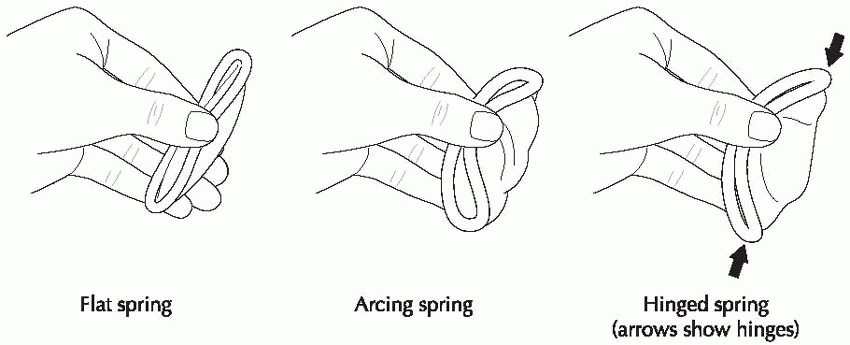 |
The latex diaphragm made with a flat metal spring or a coil spring remains in a straight line when pinched at the edges. This type is suitable for women with good vaginal muscle tone and an adequate recess behind the pubic arch. However, many women find it difficult to place the posterior edge of these flat diaphragms into the posterior cul-de-sac and over the cervix.
Arcing diaphragms are easier to use for most women. They come in two types. The All-Flex type bends into an arc no matter where around the rim the edges are pinched together. The hinged type must be pinched between the hinges to form a symmetrical arc. The hinged type forms a narrower shape when pinched together and, thus, may be easier for some women to insert. The arcing diaphragms allow the posterior edge of the diaphragm to slip more easily past the cervix and into the posterior cul-de-sac. Women with poor vaginal muscle tone, cystocele, rectocele, a long cervix, or an anterior cervix of a retroverted uterus use arcing diaphragms more successfully.
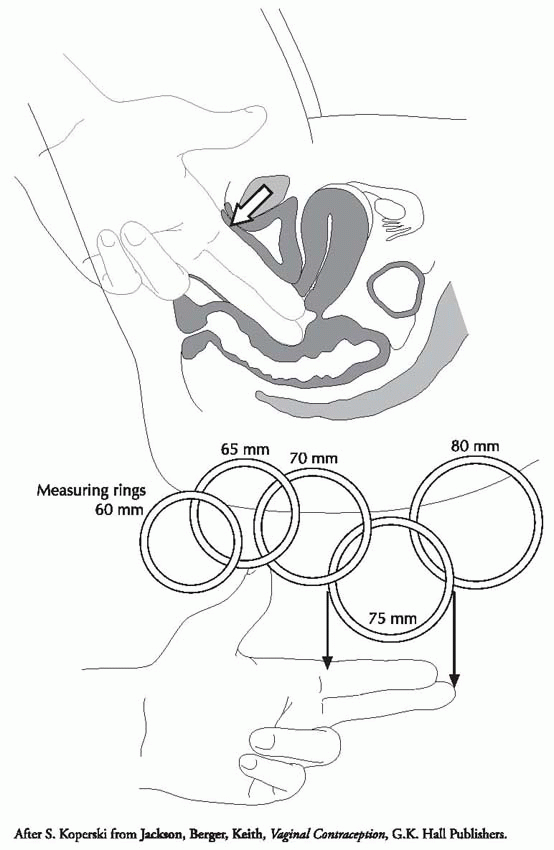 |
Fitting
Successful use of a diaphragm depends on proper fitting. The clinician must have available aseptic fitting rings or diaphragms themselves in all diameters. These devices should be scrupulously disinfected by soaking in a bleach solution. At the time of the pelvic examination, the middle finger is placed against the vaginal wall and the posterior cul-de-sac, while the hand is lifted anteriorly until the pubic symphysis abuts the index finger. This point is marked with the examiner’s thumb to approximate the diameter of the
diaphragm. The corresponding fitting ring or diaphragm is inserted, and the fit is assessed by both clinician and patient.
diaphragm. The corresponding fitting ring or diaphragm is inserted, and the fit is assessed by both clinician and patient.
If the diaphragm is too tightly pressed against the pubic symphysis, a smaller size is selected. If the diaphragm is too loose (comes out with a cough or bearing down), the next larger size is selected. After a good fit is obtained, the diaphragm is removed by hooking the index finger under the rim behind the symphysis and pulling. It is important to instruct the patient in these procedures during and after the fitting. The patient should then insert the diaphragm, practice checking for proper placement, and attempt removal.
Timing
Diaphragm users need additional instruction about the timing of diaphragm use in relation to sexual intercourse and the use of spermicide. None of this advice has been rigorously assessed in clinical studies; therefore, these recommendations represent the consensus of clinical experience.
The diaphragm should be inserted no longer than 6 hours prior to sexual intercourse. About a tablespoonful of spermicidal cream or jelly should be placed in the dome of the diaphragm prior to insertion, and some of the spermicide should be spread around the rim with a finger. The diaphragm should be left in place for approximately 6 hours (but no more than 24 hours) after coitus. Additional spermicide should be placed in the vagina before each additional episode of sexual intercourse while the diaphragm is in place.
Reassessment
Weight loss, weight gain, vaginal delivery, and even sexual intercourse can change vaginal caliber. The fit of a diaphragm should be assessed every year at the time of the regular examination.
Care of the Diaphragm
After removal, the diaphragm should be washed with soap and water, rinsed, and dried. Powders of any sort need not and should not be applied to the diaphragm. It is wise to use water to periodically check for leaks. Diaphragms should be stored in a cool and dark location.
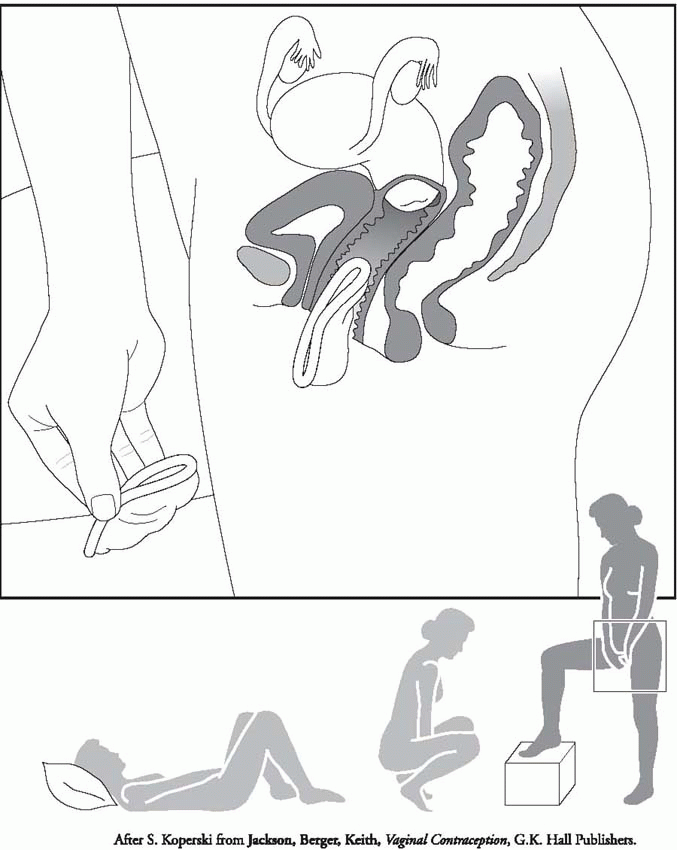 |
Diaphragm Insertion
Above: Compression of the diaphragm with the cavity facing upward.
Below: Three commonly used positions for insertion.
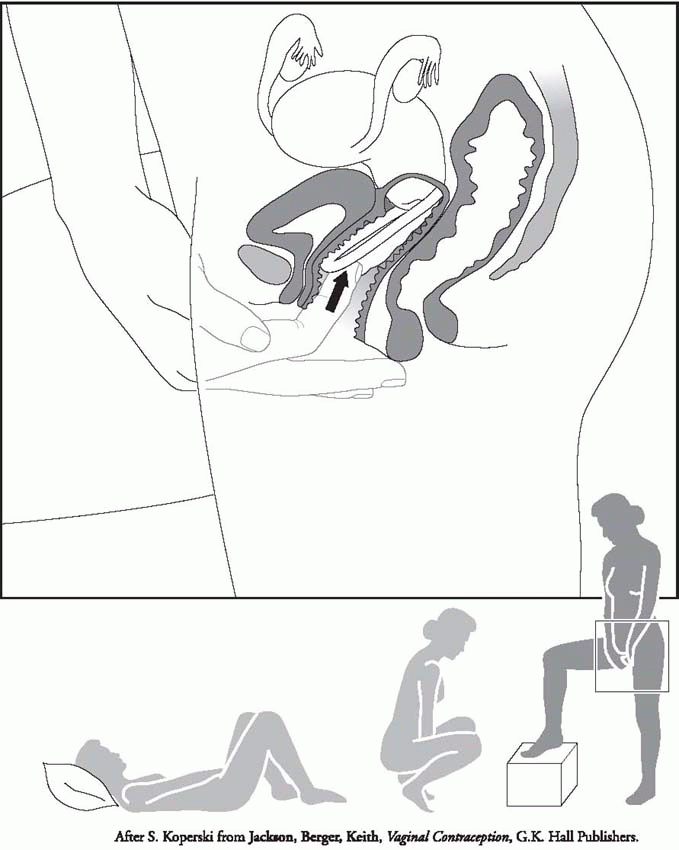 |
Diaphragm Insertion
The diaphragm is pushed into the vagina as far as it will go. The leading edge is behind the cervix. The front edge is behind the symphysis pubis.
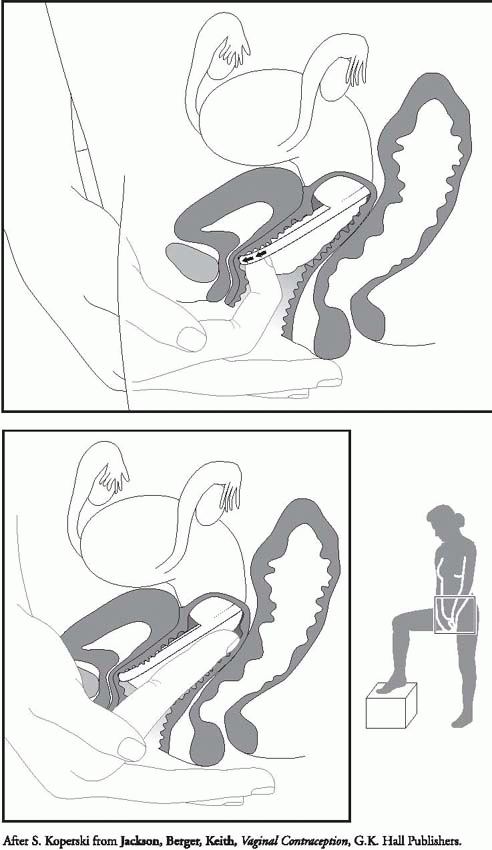 |
Checking Diaphragm Position
Above: Checking for forward movement; it should be snug.
Below: Feeling the cervix to make sure it is covered. Move the finger back and forth to feel the rim, then find the bulge in the middle.
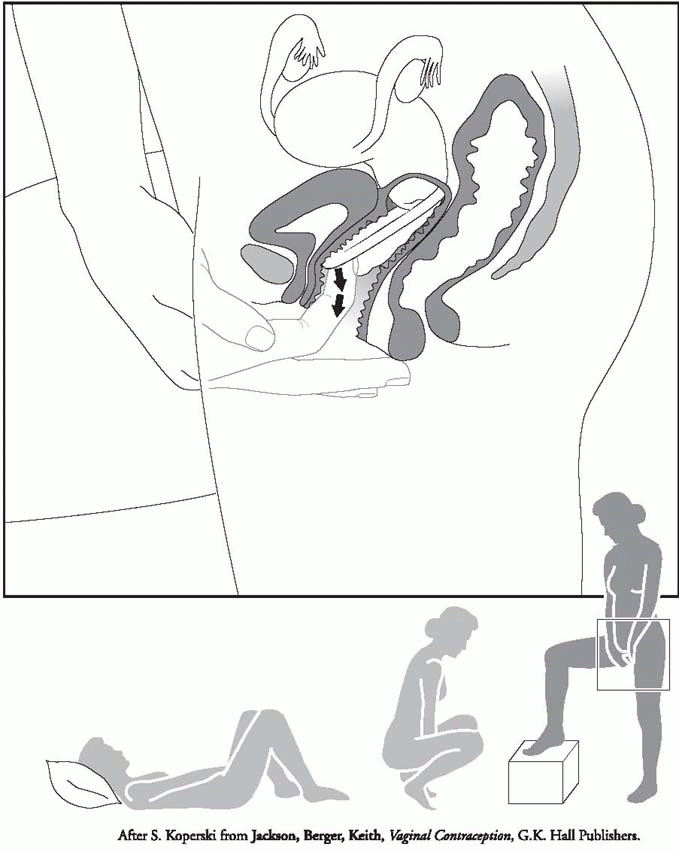 |
Diaphragm Removal
Insert the index finger under the front rim and pull downward and outward. An alternative method is to approach the diaphragm with the palm down and insert the finger between the outer edge and the vagina.
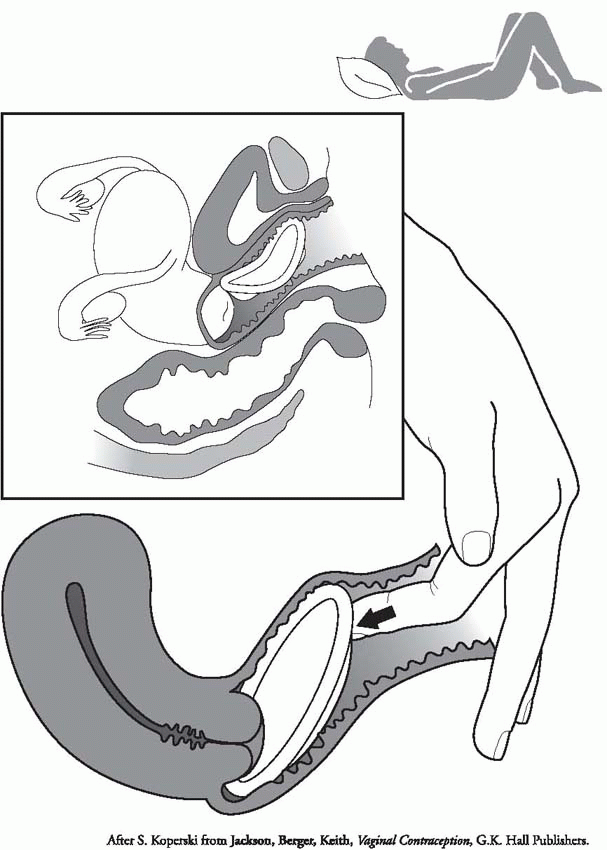 |
Incorrect Diaphragm Insertion
Above: The outer rim is correct, but the leading rim is in front of the cervix.
Below: Incorrect placement can be repositioned with a downward push on the outer edge.
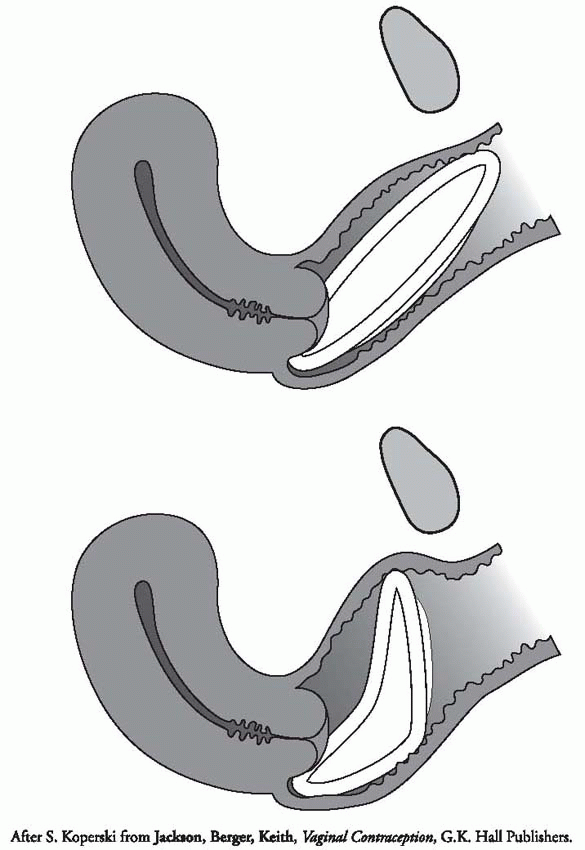 |
Incorrect Diaphragm Fit (Too Large)
Above: A diaphragm too large cannot fit behind the symphysis pubis.
Below: Forcing a diaphragm that is too large buckles the diaphragm and uncovers the cervix.
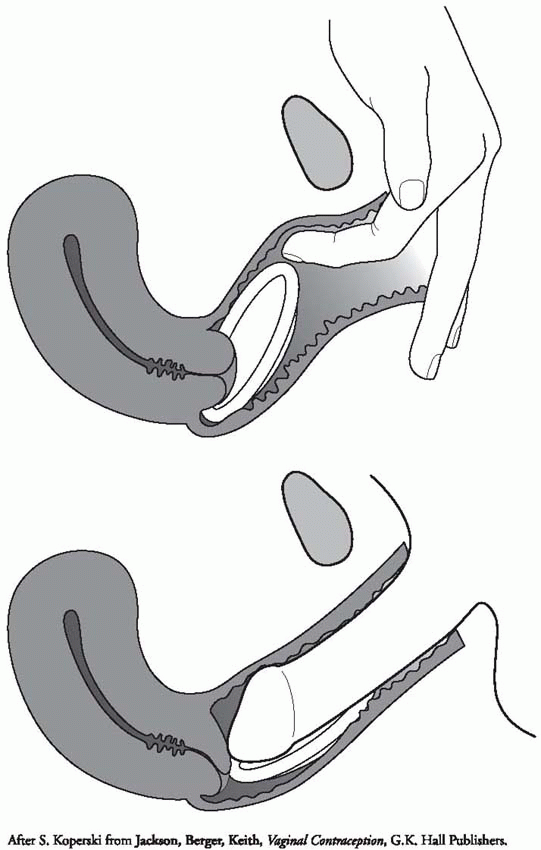 |
Incorrect Diaphragm Fit (Too Small)
Above: A diaphragm too small does not fit snugly behind the symphysis pubis.
Below: With a diaphragm too small, the penis displaces it and exposes the cervix.
The Cervical Cap
The cervical cap was popular in Europe long before its reintroduction into the United States. U.S. trials have demonstrated that the Prentif cervical cap
is about as effective as the diaphragm but somewhat harder to fit (it comes in only four sizes) and more difficult to insert (it must be placed precisely over the cervix).25,26 Efficacy is significantly reduced in parous women.
is about as effective as the diaphragm but somewhat harder to fit (it comes in only four sizes) and more difficult to insert (it must be placed precisely over the cervix).25,26 Efficacy is significantly reduced in parous women.
Stay updated, free articles. Join our Telegram channel

Full access? Get Clinical Tree


